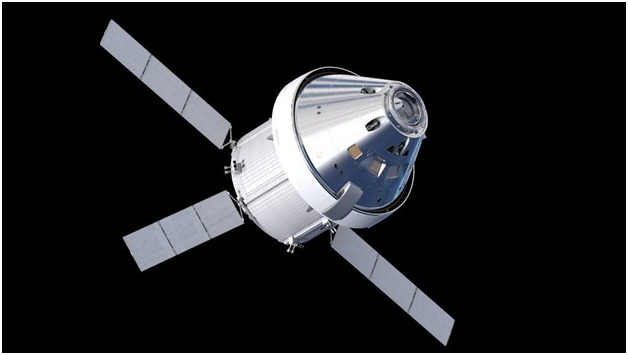Carl Sagan once said,
“Look again at that dot. That’s here. That’s home. That’s us.”
It is time we go beyond this dot.
NASA is heading back to the Moon, but instead of taking just one step, this time they are planning a much longer stay. It has been more than 50 years since the first man stepped on the moon and said those famous words: “One small step for man, one giant leap for mankind.”
Since Apollo 17, there has been a hold on lunar exploration until now. NASA’s next chapter of lunar exploration, the Artemis Mission plans to not only land men on the moon and establish a long-term human presence but also to prepare for ever more complex human missions to Mars. In short, everything that the astronauts have to do on Mars will be tried and tested initially on the Moon. NASA plans to send the first man and woman to the lunar south pole by 2024.
Now let’s have a deeper look at the Artemis mission in general:
What spacecraft are we using?
The Artemis mission has been designed to keep the comfort of astronauts as the top priority. Just like the astronauts of Project Mercury had Liberty Bell 7, Friendship 7; Apollo had Columbia, Artemis has its own deep space, human-rated spacecraft Orion.
Orion consists of three parts: a crew module, where astronauts will live and perform their operations; the service module with life support systems for the crew, its own engine and fuel reserves and a launch abort system, capable of pulling the crew module to safety in case of an emergency during launch.
The Space Launch System (SLS) will be responsible for propelling this spacecraft off of Earth. The Space Launch System which is still under development is expected to surpass the giant Saturn V, of the Apollo era, in becoming the world’s most powerful rocket. It consists of a cargo hold, an upper exploration stage, a core stage, and two solid rocket boosters.
So what makes the Artemis mission so special?
This is the first time in history that NASA and ESA are joining forces to launch a series of missions to send astronauts to the Moon and beyond. ESA’s European Service Module (ESM) aboard the Orion, will generate power, protect the astronauts from extreme hot and cold temperatures, supply air and water to the crew inside and propel the spacecraft thousands of miles away from Earth.
What are the phases of the Artemis Program?
The Artemis program has been split into two phases:
Phase 1 (2019 to 2025) will include the missions Artemis 1 to 3. Artemis 1 will depict the first flight of the SLS with the uncrewed Orion capsule, going around the moon and back, doing significant testings during its journey.
Artemis 2 will carry the first humans to the moon in the 21st century. These astronauts will orbit once around the earth, then travel to the moon and back, testing the navigation and maneuverability capabilities of the capsule. The end of Artemis 2 will see the beginning of the development of the Lunar Gateway.
Artemis 3 will have a pressurized module for landing the first humans on the Moon, in this decade. Though SLS will be carrying the humans to the Moon in the Orion, it does not have the capability of landing on the Moon. Thus, a third vehicle, a human landing system is required for landing the astronauts on the Moon. SpaceX’s Starship has been selected for this purpose.
During these three missions, NASA will also be launching a series of robotic missions on the lunar surface, called the Commercial Lunar Payload Services (CLPS), which will be responsible for delivering small scientific payloads onto the lunar surface.
Phase 2 (2025 to 2030s) will be focused on establishing a sustainable human presence on the lunar surface. This phase will also witness the testing of technologies for sending humans to Mars and the utilization of local resources for water, air, and fuel.
What is the difference between the Apollo and Artemis mission program?
The difference will be that, unlike the Apollo missions which had a constrained lander module or expendable orbiter module, the Artemis missions will use pre-staging so that everything they need is already available on the Moon when the crew lands.
This includes rovers, science experiments, human-rated systems, etc. In addition to this, the Artemis mission will have a dedicated lunar space station, capable of changing its orbit to access every part of the Moon, unlike Apollo.
What is the Lunar Gateway?
The lunar space station is called the Gateway. It can hold a robust lunar lander and have a strong communications relay. The Gateway is built such that, it can allow the addition of more modules and components as partnerships develop on Earth, opening up the possibility of having multiple human missions on the Moon at the same time.
The Gateway has the ability to change its orbit to access all parts of the Moon, but the main purpose is to place the Gateway in a unique halo orbit having apogee at 43,495 miles and perigee at 932 miles, to test and perfect the maneuvers needed for the future Mars missions.
With the boom in the growth of the space industry in terms of commercial and international opportunities, Gateway is the ideal hub between the Earth and all that lies beyond Earth.
NASA has released an official document, the Artemis Accords for establishing partnerships with other nations for taking astronauts with the Moon. The Artemis Accords are a set of bilateral agreements between the United States and partner nations about working safely and cooperatively on and around the Moon.
This is perhaps the most attractive feature of this program. In the last century, the world witnessed a space race between two superpowers of the world to establish their presence on the Moon, however this time, the world seems to be united in their vision of the lunar mission. This unity and fusion of brilliant technologies will help push humans further beyond their own expectations, into the abyss above.
Stephen Hawking captured this vision in a beautiful quote:
“We are all time-travelers, journeying together into the future. But let us work together to make that future a place we want to visit. Be brave, be determined, overcome the odds. It can be done.”
Author





“That’s one small step for man, one giant leap for mankind.”
Looking forward to more such blogs 🤜🤛
Good content! Informative and interesting!
A well written blog. The author is well versed I suppose. Give him a raise @edgeofspace
The author has exhaustively explained the concepts, it was a good read!
A wonderfully articulated blog about the Artemis mission. It clearly depicts the author’s in-depth understanding of the topic.
I’m from a computer Science background but I’ve always found areas of aerospace engineering interesting and intriguing and I like reading probabilistic blogs on space missions.
The author seems knowledgeable and has an art of wording his learnings, he had my attention throughout the blog.
Very good information .